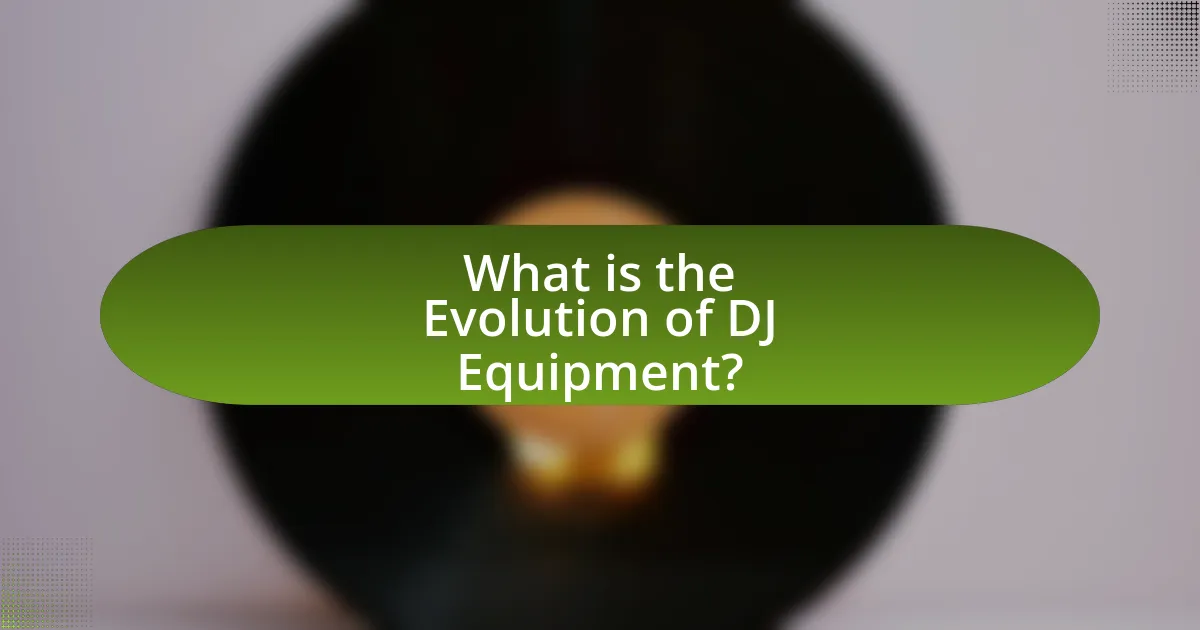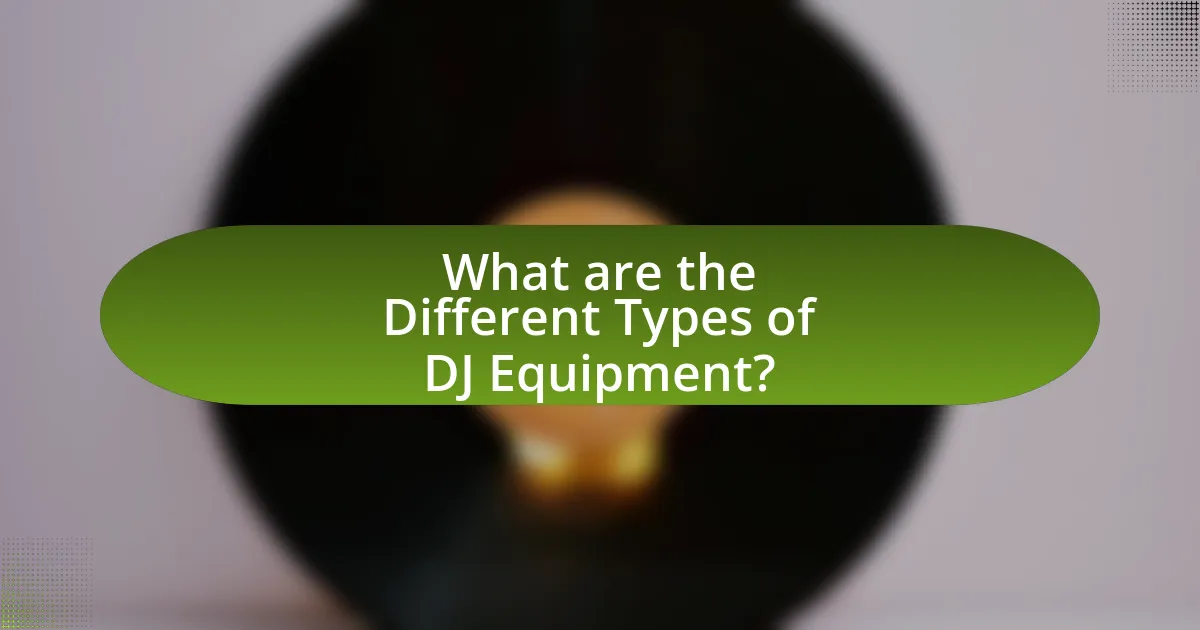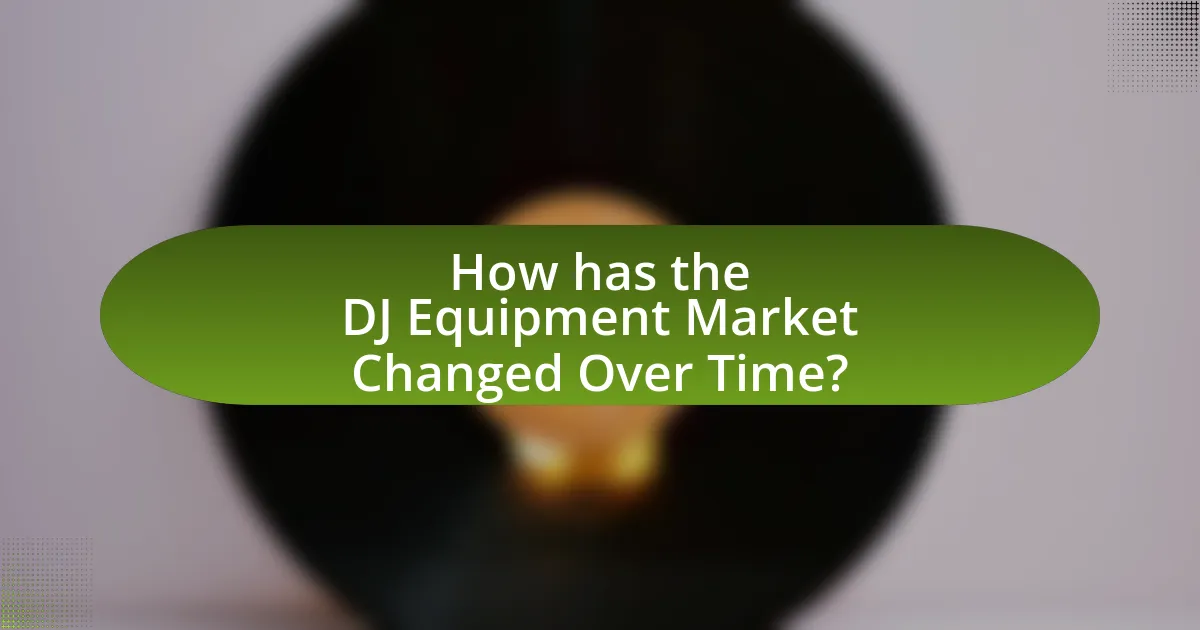The article examines the evolution of DJ equipment, tracing its development from analog turntables to modern digital controllers. It highlights key milestones, including the introduction of CDJs and software solutions like Serato and Traktor, which have transformed DJing practices. The piece also discusses the impact of technological advancements, the rise of home DJing, and the influence of streaming services on equipment usage. Additionally, it outlines the various types of DJ equipment available today, the advantages of digital controllers, and best practices for selecting gear that aligns with individual DJ styles.

What is the Evolution of DJ Equipment?
The evolution of DJ equipment has transitioned from analog turntables to digital controllers, reflecting advancements in technology and changes in music consumption. Initially, DJs used vinyl records and turntables, which allowed for manual mixing and scratching techniques. The introduction of CDJs in the 1990s marked a significant shift, enabling DJs to play digital audio files while retaining the tactile control of traditional turntables.
As technology progressed, software-based solutions like Serato and Traktor emerged, allowing DJs to manipulate music digitally with greater flexibility. This led to the development of all-in-one digital controllers that integrate hardware and software, providing features such as looping, effects, and sampling. The rise of streaming services further influenced DJ equipment, as modern controllers now often include direct access to online music libraries.
This evolution demonstrates how DJ equipment has adapted to technological advancements and changing musical landscapes, enhancing the creative capabilities of DJs.
How did DJ equipment originate and develop over time?
DJ equipment originated in the 1930s with the introduction of turntables, which allowed DJs to play and mix records. The development of DJ equipment progressed through the 1960s and 1970s with innovations such as the Technics SL-1200 turntable, which became a standard in the industry due to its direct drive motor and pitch control features. In the 1980s, the advent of the mixer allowed DJs to blend tracks seamlessly, while the introduction of digital technology in the 1990s led to the emergence of CDJs and software-based mixing solutions. By the 2000s, digital controllers and software like Serato and Traktor revolutionized DJing, enabling complex mixing and effects, thus transforming the landscape of live performances and music production.
What were the first tools used by DJs in the early days?
The first tools used by DJs in the early days were turntables and vinyl records. Turntables allowed DJs to play and manipulate music by spinning vinyl records, which were the primary medium for music playback. In the late 1940s and early 1950s, DJs began using two turntables to create seamless transitions between tracks, a technique that laid the foundation for modern DJing. This practice was further popularized in the 1970s with the rise of disco, where DJs like David Mancuso and Frankie Knuckles utilized turntables to mix tracks live, establishing the role of the DJ as a performer.
How did technological advancements influence DJ equipment?
Technological advancements significantly transformed DJ equipment by introducing digital technology, which replaced traditional analog systems. The shift from vinyl turntables to digital controllers allowed DJs to manipulate music more efficiently, utilizing software like Serato and Traktor that enabled features such as beatmatching, looping, and effects processing. This evolution is evidenced by the widespread adoption of MIDI controllers and digital audio workstations (DAWs), which provide enhanced flexibility and creativity in live performances. Additionally, advancements in hardware, such as USB connectivity and built-in sound cards, have streamlined the setup process, making it easier for DJs to perform in various environments.
What are the key milestones in the evolution of DJ equipment?
The key milestones in the evolution of DJ equipment include the introduction of the turntable in the 1940s, which allowed DJs to mix records, followed by the development of the mixer in the 1960s, enabling seamless transitions between tracks. The 1970s saw the emergence of the first DJ-specific turntables, such as the Technics SL-1200, which became a standard in the industry due to its direct drive motor and pitch control. In the 1980s, the advent of digital sampling and drum machines revolutionized DJing, allowing for more complex performances. The 1990s introduced CDJs, which enabled DJs to play digital music from CDs, further modernizing the craft. The 2000s marked the rise of digital controllers and software like Serato and Traktor, allowing for advanced mixing techniques and the integration of laptops into DJ setups. Each of these milestones significantly shaped the capabilities and techniques of DJs, reflecting technological advancements in music production and performance.
Which innovations marked the transition from analog to digital?
The innovations that marked the transition from analog to digital include the development of digital audio workstations (DAWs), MIDI (Musical Instrument Digital Interface), and the introduction of digital vinyl systems (DVS). Digital audio workstations revolutionized music production by allowing for non-linear editing and manipulation of sound, which was not possible with analog equipment. MIDI enabled electronic instruments and computers to communicate, facilitating the integration of various devices in music production. Digital vinyl systems allowed DJs to manipulate digital audio files using traditional turntables, bridging the gap between analog and digital formats. These innovations collectively transformed the landscape of music creation and performance, leading to the widespread adoption of digital technology in the industry.
How did the introduction of the CDJ change the DJ landscape?
The introduction of the CDJ revolutionized the DJ landscape by transitioning from analog turntables to digital playback, allowing DJs to manipulate music with greater flexibility and precision. CDJs enabled the use of digital audio files, which facilitated access to vast music libraries and enhanced performance capabilities through features like looping, cueing, and effects. This shift not only streamlined the setup process but also reduced the physical space required for equipment, making it easier for DJs to perform in various venues. The adoption of CDJs became widespread in the late 1990s, with models like the Pioneer CDJ-100 influencing industry standards and leading to the integration of advanced technology in DJing, such as USB connectivity and software compatibility.
What role do turntables play in the history of DJ equipment?
Turntables are foundational to the history of DJ equipment, serving as the primary tool for mixing and manipulating music since the late 1970s. They enabled DJs to create seamless transitions between tracks, introduce scratching techniques, and develop unique soundscapes, which became integral to hip-hop and dance music cultures. The Technics SL-1200, introduced in 1972, became a standard in the industry due to its durability and precision, influencing countless DJs and producers. This innovation laid the groundwork for the evolution of DJing, transitioning from vinyl to digital formats while maintaining the turntable’s influence in modern setups.
Why are turntables considered iconic in DJ culture?
Turntables are considered iconic in DJ culture because they represent the foundational technology that enabled the art of mixing and scratching. This equipment allows DJs to manipulate sound in real-time, creating unique audio experiences that are central to live performances. Historically, the introduction of the Technics SL-1200 turntable in the 1970s revolutionized DJing by providing high torque and pitch control, which facilitated beatmatching and creative mixing techniques. The turntable’s role in hip-hop culture, particularly through the work of influential DJs like Grandmaster Flash and Kool Herc, further solidified its status as a symbol of artistic expression and innovation in music.
How have turntables evolved with modern technology?
Turntables have evolved significantly with modern technology by incorporating digital features and enhanced connectivity options. Traditional analog turntables have been supplemented or replaced by digital turntables that can play music files directly from USB drives or connect to computers, allowing DJs to access vast libraries of music without the need for physical vinyl records. Additionally, many modern turntables now include built-in sound cards and software compatibility, enabling seamless integration with digital audio workstations (DAWs) and DJ software. This evolution reflects a shift towards versatility and convenience, as evidenced by the rise of hybrid models that combine analog and digital functionalities, catering to both traditionalists and modern DJs.

What are the Different Types of DJ Equipment?
The different types of DJ equipment include turntables, CDJs, digital controllers, mixers, and audio interfaces. Turntables are traditional devices used for playing vinyl records, while CDJs are digital counterparts that play music from CDs or USB drives. Digital controllers combine hardware and software to allow DJs to manipulate music files on a computer. Mixers are essential for blending audio from multiple sources, enabling seamless transitions between tracks. Audio interfaces connect DJ equipment to computers, facilitating high-quality sound output. Each type of equipment plays a crucial role in modern DJing, reflecting the evolution from analog to digital formats.
What are the main categories of DJ equipment available today?
The main categories of DJ equipment available today include turntables, mixers, digital controllers, audio interfaces, and speakers. Turntables are used for vinyl playback and scratching, while mixers allow DJs to blend multiple audio sources. Digital controllers integrate software with hardware for seamless performance, and audio interfaces facilitate sound quality and connectivity. Speakers are essential for sound output during performances. Each category plays a crucial role in modern DJ setups, reflecting the evolution from traditional to digital formats.
How do traditional turntables compare to digital controllers?
Traditional turntables primarily use vinyl records and analog technology, while digital controllers utilize digital files and software for music playback. The key difference lies in the medium and method of sound production; traditional turntables offer a tactile experience and often a warmer sound due to analog characteristics, whereas digital controllers provide versatility, portability, and access to a vast library of music formats. Digital controllers also enable advanced features such as looping, effects, and seamless transitions, which are less feasible with traditional turntables. This evolution reflects the shift in DJing from a purely analog approach to a more technology-driven practice, catering to modern demands for convenience and creativity in music mixing.
What features distinguish various types of mixers?
Various types of mixers are distinguished by features such as the number of channels, types of inputs and outputs, built-in effects, and control layouts. For instance, a two-channel mixer typically allows DJs to blend two audio sources, while a four-channel mixer provides more flexibility for mixing multiple sources simultaneously. Additionally, mixers may offer different input types, including line, phono, and USB, which cater to various equipment like turntables and digital devices. Built-in effects, such as reverb or echo, enhance sound manipulation, while control layouts, including faders and knobs, affect user experience and workflow. These features collectively define the functionality and versatility of mixers in DJ setups.
What are the advantages of using digital controllers over traditional equipment?
Digital controllers offer several advantages over traditional equipment, primarily in terms of versatility, precision, and ease of use. Digital controllers allow DJs to manipulate music with greater flexibility, enabling features such as looping, sampling, and effects that are not easily achievable with analog turntables. Additionally, digital controllers provide precise control over sound quality and beat matching, which enhances performance accuracy. The integration of software with digital controllers allows for real-time access to vast music libraries and advanced editing capabilities, streamlining the DJing process. Furthermore, digital controllers often come with built-in features like MIDI mapping and customizable layouts, which enhance user experience and adaptability during live performances.
How do digital controllers enhance a DJ’s performance?
Digital controllers enhance a DJ’s performance by providing advanced features such as real-time effects manipulation, seamless track transitions, and precise beat matching. These controllers integrate software capabilities that allow DJs to access vast libraries of music, apply effects instantly, and utilize looping and sampling functions, which were more cumbersome with traditional turntables. For instance, digital controllers often include built-in sound cards and MIDI compatibility, enabling DJs to connect to various software platforms like Serato or Traktor, which further streamlines their workflow and enhances creativity during live performances. This technological evolution has transformed the DJing landscape, allowing for more dynamic and engaging sets that captivate audiences.
What are the limitations of digital controllers compared to turntables?
Digital controllers have limitations compared to turntables primarily in terms of tactile feedback and the authenticity of the mixing experience. Turntables provide a physical connection to the music through vinyl, allowing DJs to manipulate sound with precision and feel, which many digital controllers lack due to their reliance on screens and buttons. Additionally, turntables offer a unique sound quality associated with analog recordings, which some audiophiles prefer over the often compressed audio files used in digital formats. Furthermore, the skill of beatmatching by ear, a fundamental DJ technique, is more naturally developed on turntables, while digital controllers often include automatic syncing features that can diminish this skill.
What accessories are essential for modern DJs?
Essential accessories for modern DJs include headphones, DJ controllers, audio interfaces, and USB drives. Headphones are crucial for cueing tracks and ensuring sound quality, while DJ controllers allow for seamless mixing and manipulation of music. Audio interfaces enhance sound output and connectivity with other devices, and USB drives are essential for storing and transferring music files. These accessories collectively enhance a DJ’s performance and adaptability in various settings, reflecting the evolution of DJ equipment from traditional turntables to advanced digital systems.
Which headphones are best suited for DJing?
The best headphones suited for DJing are the Sennheiser HD 25. These headphones are favored by professional DJs due to their lightweight design, excellent sound isolation, and high sound pressure levels, which allow for clear monitoring in loud environments. The Sennheiser HD 25 has a frequency response of 16 Hz to 22 kHz, ensuring a wide range of sound reproduction, and their durable construction makes them ideal for the rigors of live performances. Additionally, their one-ear listening capability is essential for DJs who need to monitor tracks while engaging with the audience.
How do software programs complement DJ equipment?
Software programs enhance DJ equipment by providing advanced features such as digital mixing, track analysis, and effects processing. These programs allow DJs to manipulate audio files with precision, enabling seamless transitions and creative sound design. For instance, software like Serato DJ and Traktor Pro integrates with hardware controllers, allowing real-time control over various parameters, which enhances the overall performance experience. Additionally, software can analyze tracks for BPM and key, facilitating better song selection and mixing strategies. This integration of software and hardware has revolutionized DJing, making it more accessible and versatile for both amateur and professional DJs.

How has the DJ Equipment Market Changed Over Time?
The DJ equipment market has evolved significantly from traditional turntables to advanced digital controllers. Initially, the market was dominated by vinyl turntables and analog mixers, which required extensive manual skill and physical media. As technology progressed, the introduction of CDJs in the 1990s allowed DJs to play digital music from CDs, enhancing convenience and accessibility.
The 2000s saw the rise of software-based DJing, with programs like Serato and Traktor enabling DJs to mix music directly from laptops, further shifting the market towards digital solutions. By the 2010s, the proliferation of MIDI controllers and all-in-one digital DJ systems transformed the landscape, allowing for more intuitive and versatile performances.
Market research indicates that the global DJ equipment market was valued at approximately $1.5 billion in 2020 and is projected to grow at a CAGR of around 5% through 2027, driven by the increasing popularity of electronic dance music and live performances. This shift reflects a broader trend towards digitalization in the music industry, emphasizing the importance of technology in modern DJing.
What trends have emerged in the DJ equipment market?
The DJ equipment market has seen a significant trend towards digital controllers and software integration. This shift is driven by the increasing demand for versatility and portability among DJs, as digital controllers allow for a wide range of functionalities in a compact form. According to a report by Research and Markets, the global DJ equipment market is projected to grow at a CAGR of 4.5% from 2021 to 2026, highlighting the rising popularity of these digital solutions. Additionally, the incorporation of features such as built-in effects, sampling capabilities, and seamless connectivity with music streaming services has further solidified the preference for digital equipment over traditional turntables.
How has the rise of home DJing affected equipment sales?
The rise of home DJing has significantly increased equipment sales, particularly in digital controllers and software. As more individuals engage in DJing from home, the demand for affordable and user-friendly equipment has surged, leading to a notable growth in sales figures. For instance, the global DJ equipment market was valued at approximately $1.2 billion in 2020 and is projected to grow at a compound annual growth rate of around 5% through 2027, driven largely by the home DJing trend. This shift has prompted manufacturers to innovate and produce a wider range of products tailored for amateur DJs, further boosting sales in this segment.
What impact has streaming services had on DJ equipment usage?
Streaming services have significantly transformed DJ equipment usage by enabling access to vast music libraries and facilitating real-time music mixing. DJs now rely on software integrated with streaming platforms, allowing them to access and play tracks directly from these services during live performances. This shift has led to the increased popularity of digital controllers and software solutions, such as Serato and Rekordbox, which support streaming capabilities. According to a 2021 report by DJ Mag, over 60% of DJs now use streaming services in their sets, illustrating the profound impact on equipment choices and performance styles.
What are the future prospects for DJ equipment development?
The future prospects for DJ equipment development include advancements in technology, integration of artificial intelligence, and enhanced user interfaces. As digital technology continues to evolve, DJ equipment is likely to incorporate more sophisticated features such as real-time audio analysis and automated mixing capabilities, which can streamline the creative process for DJs. Furthermore, the rise of virtual reality and augmented reality may lead to immersive DJ experiences, allowing for innovative performances that engage audiences in new ways. The increasing demand for portability and connectivity will also drive the development of compact, wireless devices that maintain high audio quality. These trends are supported by the growing market for DJ equipment, which was valued at approximately $1.2 billion in 2020 and is projected to grow at a CAGR of 3.5% through 2027, indicating a robust future for technological advancements in this field.
How might emerging technologies shape the next generation of DJ gear?
Emerging technologies will significantly shape the next generation of DJ gear by integrating advanced features such as artificial intelligence, machine learning, and augmented reality. These technologies enable DJs to automate mixing processes, analyze crowd preferences in real-time, and create immersive visual experiences that enhance performances. For instance, AI-driven software can suggest track combinations based on historical data and audience reactions, improving the overall quality of live sets. Additionally, augmented reality can provide DJs with interactive interfaces, allowing for more dynamic control over their performances. This evolution reflects a broader trend in the music industry towards personalization and enhanced user experience, as evidenced by the increasing adoption of smart devices and applications in live music settings.
What role will virtual reality play in DJ performances?
Virtual reality will enhance DJ performances by creating immersive environments that engage audiences in new ways. This technology allows DJs to transport listeners into virtual spaces where they can experience music visually and interactively, thus transforming traditional performances into multi-sensory experiences. For instance, platforms like Oculus Venues have already demonstrated how virtual reality can host live music events, enabling fans to attend from anywhere in the world while feeling present in a shared space. This evolution aligns with the ongoing trend of integrating technology into live music, as evidenced by the increasing use of digital tools and software in DJing.
What are some best practices for choosing DJ equipment?
When choosing DJ equipment, prioritize compatibility with your existing setup and the specific needs of your performances. Selecting equipment that integrates seamlessly with your software and hardware ensures a smoother workflow and enhances performance quality. For instance, if you use Serato DJ software, opt for controllers that are Serato-compatible to leverage its features fully. Additionally, consider the type of events you will be performing at; mobile DJs may require portable and versatile gear, while club DJs might prioritize high-quality sound and advanced features. Researching user reviews and expert recommendations can provide insights into the reliability and performance of specific models, helping you make an informed decision.
How can DJs determine the right equipment for their style?
DJs can determine the right equipment for their style by assessing their musical genre, performance environment, and personal preferences. For instance, a DJ specializing in electronic dance music may prefer digital controllers for their versatility and integration with software, while a turntablist might opt for traditional turntables to execute scratching techniques. Additionally, evaluating the size and layout of the performance space can influence equipment choice; larger venues may require more powerful sound systems and mixers. Research indicates that 70% of DJs prioritize equipment that enhances their specific performance style, highlighting the importance of aligning gear with individual artistic expression.
What common mistakes should DJs avoid when purchasing gear?
DJs should avoid purchasing gear based solely on brand reputation or trends rather than their specific needs and skill level. Many DJs make the mistake of investing in high-end equipment without understanding its features or how it fits into their performance style. For instance, a beginner might buy a professional-grade mixer that exceeds their current capabilities, leading to frustration and underutilization. Additionally, failing to consider compatibility with existing gear can result in costly returns or additional purchases. Research indicates that 70% of DJs regret their initial gear choices due to lack of proper evaluation, highlighting the importance of informed decision-making.



